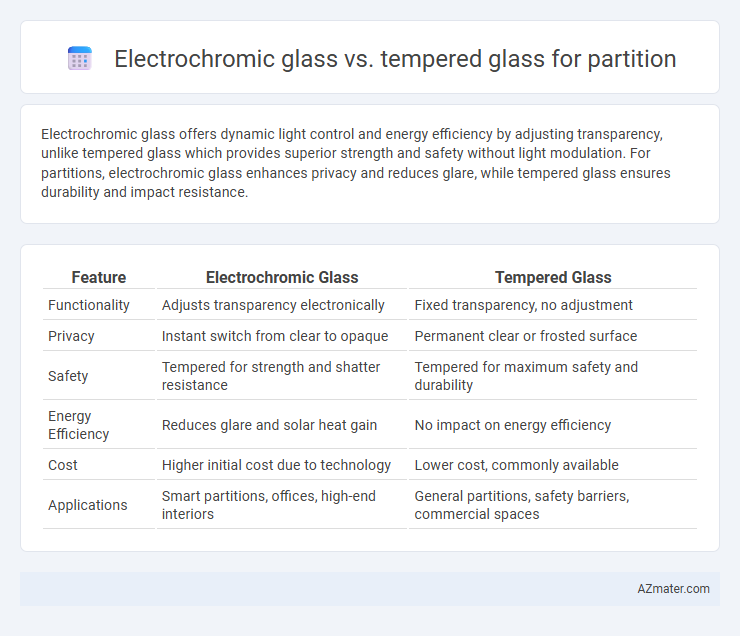Electrochromic glass offers dynamic light control and energy efficiency by adjusting transparency, unlike tempered glass which provides superior strength and safety without light modulation. For partitions, electrochromic glass enhances privacy and reduces glare, while tempered glass ensures durability and impact resistance.
Table of Comparison
| Feature | Electrochromic Glass | Tempered Glass |
|---|---|---|
| Functionality | Adjusts transparency electronically | Fixed transparency, no adjustment |
| Privacy | Instant switch from clear to opaque | Permanent clear or frosted surface |
| Safety | Tempered for strength and shatter resistance | Tempered for maximum safety and durability |
| Energy Efficiency | Reduces glare and solar heat gain | No impact on energy efficiency |
| Cost | Higher initial cost due to technology | Lower cost, commonly available |
| Applications | Smart partitions, offices, high-end interiors | General partitions, safety barriers, commercial spaces |
Introduction to Partition Glass Options
Electrochromic glass offers dynamic light control and privacy by changing opacity with electrical input, ideal for adaptable partition solutions in modern offices. Tempered glass provides superior strength and safety, making it a reliable choice for fixed partitions requiring durability and impact resistance. Both materials serve distinct functional and aesthetic purposes depending on the spatial and design requirements of interior partitions.
What is Electrochromic Glass?
Electrochromic glass, also known as smart glass, changes its transparency when an electric voltage is applied, allowing users to control light and privacy levels instantly. Unlike tempered glass, which is heat-treated for strength and safety but remains static in appearance, electrochromic glass offers dynamic tinting properties that enhance energy efficiency and visual comfort. This technology is ideal for partitions in office or residential spaces seeking both privacy and modern aesthetic control.
What is Tempered Glass?
Tempered glass is a type of safety glass processed by controlled thermal or chemical treatments to increase its strength compared to normal glass, making it highly resistant to impact and thermal stress. This glass is commonly used in partitions due to its durability and ability to shatter into small, less harmful pieces when broken, enhancing safety in commercial and residential spaces. Compared to electrochromic glass, tempered glass lacks dynamic light control features but excels in structural integrity and safety performance.
Key Differences Between Electrochromic and Tempered Glass
Electrochromic glass features dynamic light control by changing transparency with electrical input, enhancing privacy and energy efficiency in partitions, whereas tempered glass offers exceptional strength and safety due to heat treatment but lacks adjustable opacity. Electrochromic glass provides smart functionality for controlling glare and heat, suitable for modern office environments, while tempered glass prioritizes durability and impact resistance, ideal for high-traffic or safety-critical areas. The cost of electrochromic glass is higher with integrated technology, contrasted with the more affordable and widely available tempered glass designed for structural support.
Light Control and Privacy Features
Electrochromic glass offers dynamic light control by adjusting transparency levels to regulate natural light and enhance privacy on demand, making it ideal for adaptable partition solutions. Tempered glass, while providing strength and safety, remains fixed in transparency and requires additional treatments like blinds or films for privacy control. Electrochromic partitions optimize energy efficiency and occupant comfort by shifting from clear to opaque states, whereas tempered glass primarily ensures durability without integrated light modulation capabilities.
Energy Efficiency Comparison
Electrochromic glass offers superior energy efficiency for partitions by dynamically controlling solar heat gain and reducing reliance on HVAC systems, cutting cooling costs by up to 30%. Tempered glass, while strong and safe, lacks adjustable transparency, resulting in higher energy consumption due to unchecked solar heat transfer. Utilizing electrochromic glass in partitions enhances thermal insulation and daylight management, significantly lowering building energy use compared to traditional tempered glass.
Safety and Durability
Electrochromic glass offers advanced safety features with its ability to switch from transparent to opaque, providing privacy without compromising structural integrity, while tempered glass is renowned for its high impact resistance and shatters into small, less harmful pieces upon breakage. Electrochromic glass incorporates layers that enhance durability against scratches and environmental damage, whereas tempered glass is thermally treated to withstand significant stress and temperature fluctuations. For partitions, tempered glass ensures robust physical protection, while electrochromic glass adds functional safety through controlled visibility and enhanced material strength.
Cost Analysis: Electrochromic vs Tempered Glass
Electrochromic glass typically carries higher initial costs compared to tempered glass due to advanced technology and installation requirements, with prices ranging from $100 to $150 per square foot versus $30 to $50 for tempered glass. Long-term savings from electrochromic glass arise from energy efficiency and reduced need for blinds or curtains, potentially offsetting upfront expenses in commercial and residential partitions. Tempered glass offers a budget-friendly solution with strong durability and safety features but lacks the dynamic light control and privacy benefits inherent to electrochromic glass.
Installation and Maintenance Considerations
Electrochromic glass requires specialized electrical wiring and integration with control systems during installation, which can increase complexity and cost compared to tempered glass that relies on standard framing without electrical components. Maintenance for electrochromic glass involves periodic inspection of electronic controls and potential replacement of smart film layers, while tempered glass demands minimal upkeep, primarily cleaning and checking for physical damage. For partition applications, tempered glass offers straightforward installation and durable, low-maintenance performance, whereas electrochromic glass provides dynamic light control but necessitates more technical expertise and ongoing maintenance.
Best Applications for Each Glass Type
Electrochromic glass is best suited for office partitions and smart homes where privacy control and energy efficiency are priorities, offering adjustable transparency with a simple switch. Tempered glass excels in high-traffic commercial spaces and safety-critical environments due to its superior strength, impact resistance, and shatterproof properties. Using electrochromic glass maximizes natural light management and privacy, while tempered glass ensures durability and safety in partitions exposed to potential impact or stress.

Infographic: Electrochromic glass vs Tempered glass for Partition
 azmater.com
azmater.com